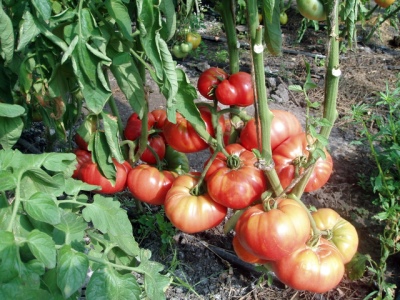
- Authors: Ugarova S.V., Dederko V.N., Postnikova O.V.
- Year of approval: 2008
- Category: grade
- Growth type: indeterminate
- Appointment: fresh consumption, for juice, for ketchup and tomato paste
- Ripening period: early
- Ripening time, days: 108
- Growing conditions: for open ground, for film greenhouses, for closed ground
- Marketability: high
- Transportability: high
The Great Warrior tomato is one of the well-established varieties. Despite this, you need to familiarize yourself with it more closely and carefully in order to exclude errors during cultivation. It is worth finding out where this culture can grow and under what conditions, what gardeners can count on.
Breeding history
The great warrior appeared relatively recently. Its cultivation in private gardens has been allowed since 2008. The breeding program was authored by Ugarova, Dederko and Postnikova. These names themselves are widely known and act as a guarantee of the quality of culture.
Description of the variety
The great warrior is an indeterminate plant. It fits:
for free soil;
for film greenhouses;
for professional indoor greenhouses.
The high marketability of the crop testifies in favor of this crop. The bushes of the Great Warrior can rise up to 1.5-2 m. They are distinguished by their power and growth activity. Large leaves turn dark green.
The main qualities of the fruit
The green unripe berries of such a tomato have a rich green spot at the stalk. As it ripens, the fruit acquires a raspberry color. Its size can reach 250 g, and sometimes 300 g. In shape, the Great Warrior's tomatoes resemble a flat circle. Their ribs are relatively unobtrusive. 5 or 6 berries develop on 1 brush.
Taste characteristics
Tomatoes of the variety have a sweet and sour taste. The pulp is of moderate density and rather sugary. Tasters note its juiciness.
Ripening and fruiting
The Great Warrior is a typical early tomato. It is necessary to wait for the appearance of the crop for about 108 days after throwing out the green growth. Then fruiting will take a long time. It is these circumstances that allow the plant to be considered the optimal choice for any gardener.
Yield
The great warrior is great also in his fertility. Berry picking can reach 9.5 kg per 1 bush. To achieve this result, you will need to observe the subtleties of agricultural technology.
The timing of planting seedlings and planting in the ground
Seeds should be sown in February or March, depending on the region and the actual weather. Typically, the seedlings will be ready to be transplanted outdoors at 50-60 days. In this case, you need to evaluate:
her own fortune;
site features;
current and forecast weather.

Growing tomato seedlings is an extremely important process, because it largely depends on whether the gardener will be able to harvest at all. All aspects must be taken into account, from seedbed preparation to planting in the ground.
Landing scheme
The official description prescribes placing 3 bushes per 1 sq. m. It is necessary to form plants in 1 or 2 stems. Seedlings are usually placed according to the rule of 700x300 mm.Sometimes the order of 700x400 mm is used. The choice in a particular case must be made taking into account horticultural experience.

Growing and care
Stepson, tying up and shaping the Great Warrior is imperative. The initial garter is made under the first flower brush. Then they are engaged in a garter under each inflorescence. This approach makes the plant more resilient. Harvest uniformity is ensured by removing some of the last ovaries.
In the last 1-2 weeks before planting, the seedlings of this variety should be hardened. When forming, you need to get rid of stepchildren. During the growing season, 3 dressings are carried out:
14 days after disembarkation;
when forming 1 or 2 flower brushes;
as soon as the first massive crop is harvested.
It is necessary to water the culture only as needed. Timely weeding is critical. The choice of soils is not too fundamental. But, of course, it is better to choose a fertile soft soil. When feeding, preference should be given to phosphorus-potassium compositions.




A plant needs different micronutrients at each stage of growth. All fertilizers can be divided into two groups: mineral and organic. Folk remedies are often used: iodine, yeast, bird droppings, eggshells.
It is important to observe the rate and period of feeding. This also applies to folk remedies and organic fertilizers.
Disease and pest resistance
Cracking of berries is unlikely. Immunity to late blight and other pathologies is quite high. This plant almost does not suffer from powdery mildew. However, this dignity does not relieve gardeners of the obligation to prevent infection. Pests specific to this variety have not been described.


Resistant to adverse weather conditions
The great warrior tolerates cold weather well. The heat is also not too bad for him. However, some precautions in both cases will be useful for farmers.
Growing regions
You can cultivate the Great Warrior in:
Western and Eastern Siberia;
Primorsky and Khabarovsk Territories;
Moscow and Leningrad regions;
Krasnodar and Stavropol Territories;
Kurgan, Chelyabinsk and Sverdlovsk regions;
regions of the Chernozem and the Volga regions.
Review overview
Truck gardening lovers speak positively about this variety. They note that all the declared characteristics are met. At the same time, it is possible to preserve the harvest for a rather long time without losing its valuable properties. The plant has many enthusiastic fans. The harvested fruits are distinguished by attractive gastronomic qualities, and cultivation does not present any big problems.

























































































